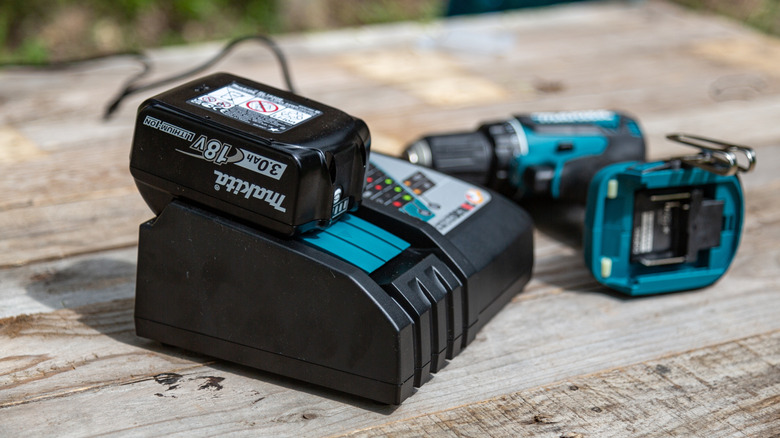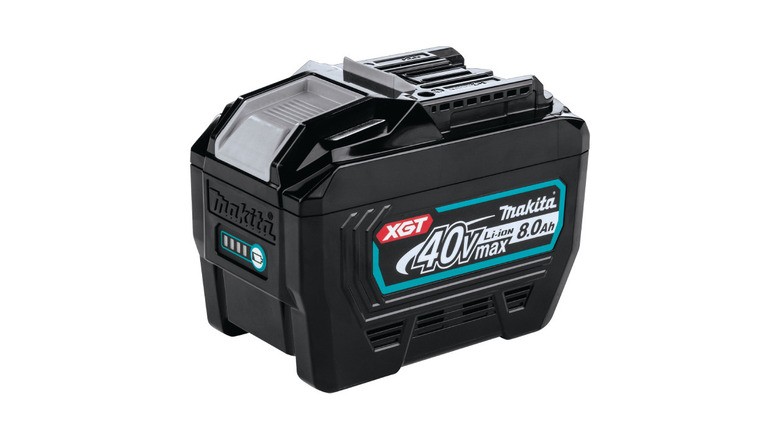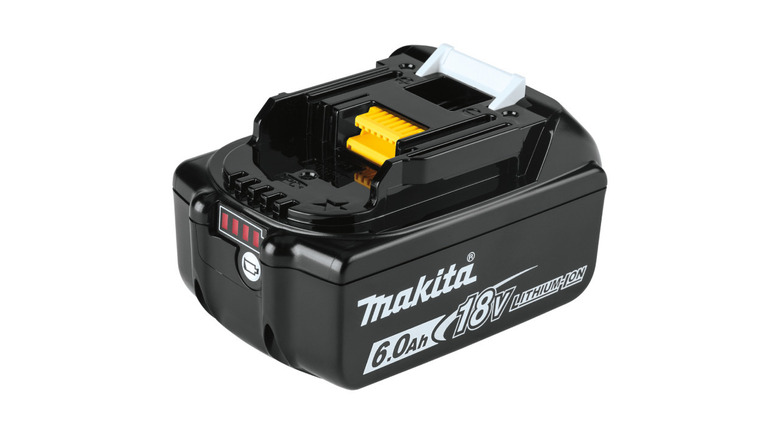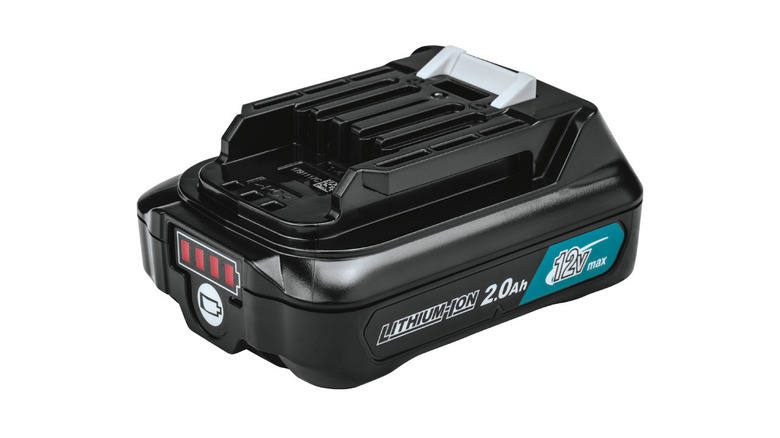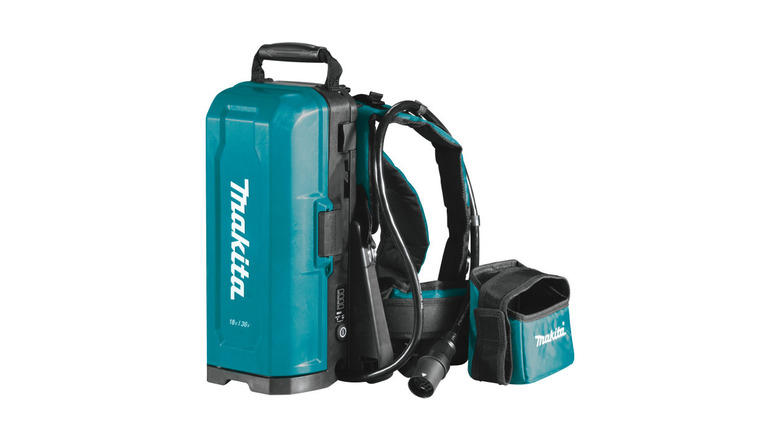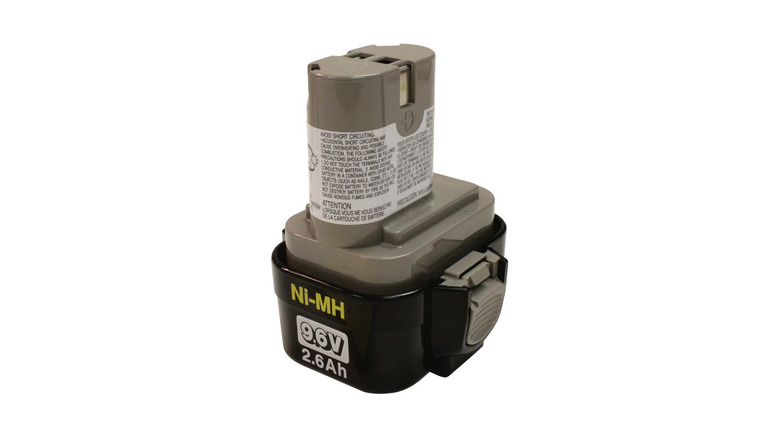Every Makita Battery Type Available In The US (And What To Use Them For)
We may receive a commission on purchases made from links.
There's a long list of things to consider before buying a Makita tool, especially if it's your first. One of those things is the battery type. Makita has three main tool lines for sale in the U.S. Each uses a different type of battery, and each type is made in different variations that can be used on every tool of the line, with the exception of some CXT tools, which can use some LXT batteries. And then there are the many unofficial adapters that let you use other manufacturers' batteries on your Makita tools and vice versa. We're going to ignore all that and focus on the four families of batteries that Makita officially sells in the United States.
We mentioned unofficial battery packs, but there are entire tool lines that aren't often on sale in the U.S. as well, the most famous of which is probably the G-Series. Those use different kinds of lithium ion batteries which, confusingly, are sold more or less everywhere. We're also going to ignore those, for the most part, since they're so rarely used. We'll also ignore the batteries that are simply not in use anymore. Finally, there's the fourth category of official Makita batteries that we will cover, called ConnectX. This line is not like the organized XGT, LXT, and CXT lines, being used instead as a catch-all category for really large batteries designed for prolonged outdoor use.
XGT (40V)
The XGT line is Makita's most powerful system and is powered by its biggest batteries. The XGT line uses two battery systems, the 40V Max and the 80V Max. The 80V systems simply use two batteries at the same time. According to Makita, this allows some of its tools to rival the power of corded equipment. That's why the XGT line can confidently aim for the professional market, placing its most high-power cordless tools right next to corded, air, and gas alternatives in the "high demand applications" sector. One interesting design choice of the XGT batteries, which makes the dual battery system much more feasible, is their small size. The manufacturer notes on its website that those 40V batteries are only slightly bigger than the 18V batteries of the LXT line.
The XGT 40V batteries are available in 2.5Ah, 4.0Ah, and 5.0Ah capacities. A high Ah, or ampere hours, and the high 40V voltage mean that those batteries have a very large energy charge and maximum output, but take some time to charge from zero to 100%. The higher the Ah value, the longer it will take and the more energy will be stored. Of course, that energy needs to be stored somewhere. That's why a high Ah value is associated with bulky batteries. 40V battery systems are used in XGT tools, both big and small, from pin nailers and combi drills to demolition hammers. Recently, Makita launched a new type of XGT battery, the VL4040F, which promises to deliver more power at the same voltage and ampere hours.
LXT (18V)
The LXT is the Makita cordless line, which the company considers ideal for most applications and aims at the average tool user. It's also the company's largest battery system and, according to Makita, "the world's largest compatible 18V slide-style battery system", with over 350 compatible products. Like with the XGT 40V batteries, there are different types of LXT batteries, which influence the duration and the size of the charge. LXT batteries are all 18V and range between 2Ah and 6Ah. And like its bigger Makita sibling, the X2 line can combine two LXT 18V batteries into one tool, delivering twice the power. The system is divided into three tiers: the 36V tools (activated with two 18V batteries), the LXT Premium for more demanding tasks, and the small form factor Sub-Compact tools. The last two use a single 18V battery per tool.
It can be hard to pick the right Makita system between XGT, LXT, and XCT. They all have their applications, but if you're undecided, LXT is where you should look first. The reason is the batteries and the number of tools in the line. The three Makita systems use three different kinds of batteries (40V, 18V, and 12V) that adapt to many tools in each line. Being the brand's biggest, the LXT line likely has every cordless tool you'll ever need. A single battery and charger combo lets you power all those tools, which include a powerful mini-blower and inflator and other 18V tools that users often recommend.
CXT (12V)
The CXT is the newest and smallest lineup of tools in Makita's extensive repertoire, promising compact solutions that put comfort and precision before power. In the company's own words, the 12V CXT tools provide "professional performance with superior ergonomics and comfort". That this underpowered line would be a little cheaper than the LXT tools seems like a given, but that's not always the case, perhaps due to the popularity of the brand's 18V gear. While quite a few of Makita's tools under $100 are part of the CXT line, the difference with its LXT counterpart is often negligible. As an example, two nearly identical cordless inflators by Makita, the LXT DMP180Z and the CXT MP100DZ, are sold at just $20 apart, while the batteries and charger are often found at a similar price.
That said, while saving $20 for a tool that is less powerful and holds far less charge doesn't sound like a great deal, the reduced weight and size of many CXT tools can be an advantage in and of itself. 12V CXT batteries come in 2.0Ah and 4.0Ah varieties. As usual, a higher Ah value means bigger batteries, both in capacity and size. We should probably note that, for a lot of tools, the cheapest CXT batteries don't really compare with the rest of Makita's batteries. The energy capacity of a battery is decided by both volts and ampere-hours. The capacity of a 12V 2Ah battery is not very high, coming at 24 watt-hours against the 72 watt-hours of the cheapest LXT battery and charger combo we could find.
ConnectX battery backpack and portable power supply
While there is some overlap with other types of Makita batteries, the brand's portable power stations and backpacks belong to a category of their own. That category is known as ConnectX, a line dedicated to big, adaptable, and unconventional equipment that can power most of Makita's tools, from the XGT and LXT lines to exclusive tools like brush cutters and blowers, thanks to direct connection support. Part of this equipment, like the Portable Backpack Power Supply, is powered by a number of LXT 18V batteries and can run all the tools those batteries can run and more for significantly longer.
Meanwhile, the 40V max ConnectX™ Portable Power Station is, well, a power station. It features a lot of outlets of different kinds (AC outlets, USB-A and USB-C, and a 12V DC car outlet), but, vitally, it's not a battery. Instead, it's the bridge that turns the DC power of the two Makita power supplies (the PDC1500 and PDC1200) into AC power. However, the power supplies can be used independently of the power station, either mounted on tools like lawn mowers and blowers or carried like a backpack with a harness, which is sold separately. The cost is where those extremely powerful batteries falter a bit. For some, mostly professionals, it might be worth investing in a battery that can power just about anything you can throw at it and everything that Makita makes. One distributor puts the PDC1200, the least powerful supply, at $1,379. The Portable Backpack Power Supply is a little cheaper, at $599, but it's far more expensive than any other Makita battery.
Out of production batteries
Those are all the batteries that Makita currently sells in the US, but this doesn't cover all the batteries you can find for sale. Chances are, you can still find some Makita tools that use different batteries than the ones explained above on the local used market. Retired battery types from Makita include the 36V, 14.4V, and 7.2V lithium-ion, and a few nickel–metal hydride and nickel–cadmium batteries. The G-Series is a different story. Not to be confused with the CXT, another cheap entry in Makita's lineup, the G-Series was only added in 2016 but seems to be on its way out. Those tools are still available in some countries, but they aren't sold in the United States.
When those old batteries finally fail, you should probably get rid of those tools. We wouldn't normally advocate for replacing a tool that still works, but getting a new battery for a line of power tools no longer in development is only going to get harder as time moves on. Even the ones that Makita still sells are far more expensive than they have any right to be. For example, an 18V/4.0Ah battery used by the LXT tools costs about $70. Meanwhile, a spare of the old 14.4V/1.3Ah batteries from Makita is sold at $137.53. Both batteries are lithium ion, too, so there's really no way of justifying the difference in price beyond the fact that no one really uses those tools anymore.
